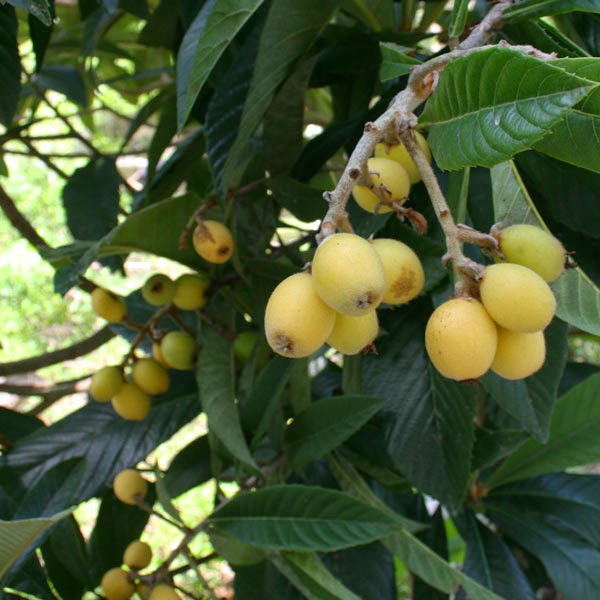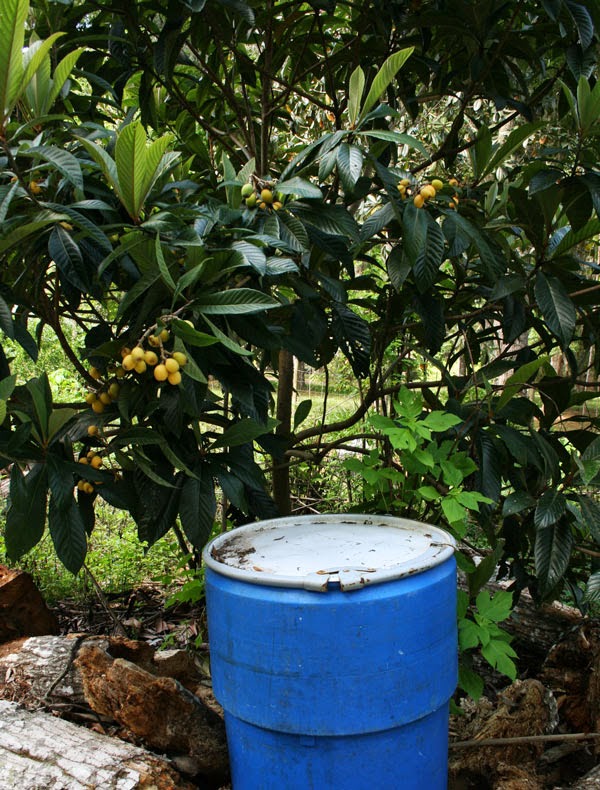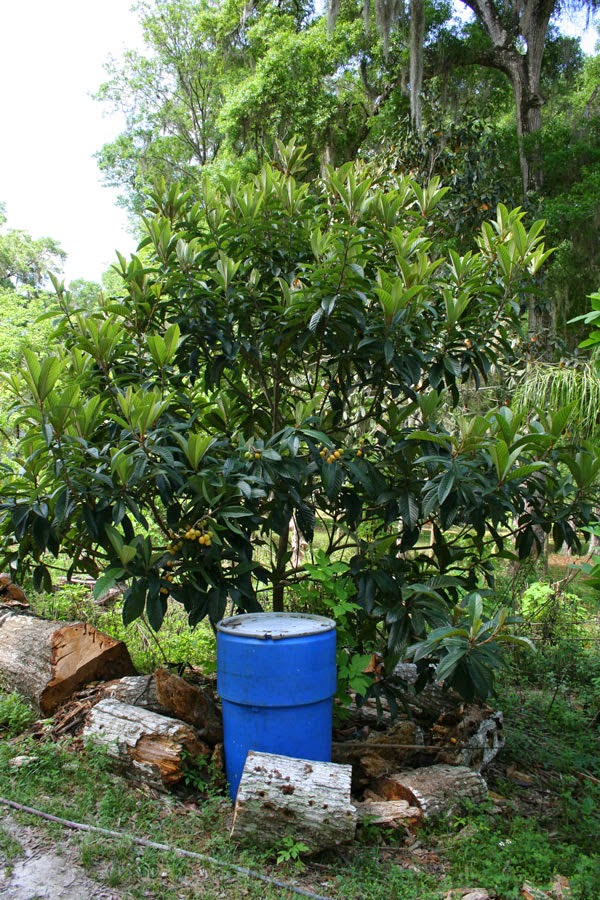These are the first fruits to appear on this loquat tree. It’s likely 6 years old, though I planted it 2 years ago.
We had a late frost this year that would have taken all the fruit off this tree… except for the fact that I had a secret weapon!
That is a drum filled with liquid plutonium.
No. It’s not. It’s just water.
The thermal mass of that water, along with a few thrift store sheets and blankets made a big difference.
Look at the entire loquat tree:
I’m not sure if you can see it in this photo, but the only place on the entire loquat tree that held fruit was the portion right around the barrel of water.
Loquat fruit are only cold-hardy down to 25 degrees, though the rest of the tree can easily handle the teens, so protecting loquat fruit from frost is vital.
Because I HAD to know what the fruit on this tree tasted like, I covered that one corner of the tree, plus added the barrel – and it worked like a charm. Water holds a lot of energy. You can use this trick to protect young citrus and other tender plants as well. Just tuck a barrel right next to the trunk and cover the plant with a blanket or sheet to keep the heat of the water in.
It works.
Unfortunately, the loquats are really lemony-tart and sour (which has nothing to do with the cold weather). Not all loquat trees are created equal, which is why I wanted to see what this seedling tree would bear.
Now I know it needs to be grafted with scions from an improved cultivar. It’ll take some work, but will greatly improve the fruit. I’ve waited 4 years for fruit – why not graft and wait one more?
I’ve got time.
For now, I’ll just pretend it’s a cold-hardy lemon.
Learn more about loquats and other wonderful trees in David the Good’s book Create Your Own Florida Food Forest.





13 comments
Our two loquat trees are 5 years old and we are still waiting for them to bear fruit. Of course, now that we are moving to a new location, the trees no doubt will start blossoming.
In my experience, loquat trees start to bear fruit after their 7th season. However, I live in the UK, and I strongly suspect that this varies according to climatic zone, soil type, etc. If you live in a Mediterranean or sub-tropical type climate, for example, I’m sure that is likely reduced to less than 7 yrs.
I hope the move went smoothly for you at least.
Another water thermal mass success story. I grow banana plants near my pool instead of the standard robellini. The leaves hanging directly over the pool all the way back to the leaves within 2' of the pool were undamaged. The ones farther away from the pool were fried. I live in Orlando so we only had 2 freezing nights this year. The banana fruit survived just fine! At least my pool is useful for something in the winter time!
What a terrific idea. My idea/s involved ‘fleece’, polythene sheets, outdoor xmas tree lights and a paraffin lamp. I might just try the water barrel idea as well for good measure.
Thank you. It works quite well.
I have used milk jugs & anything else with a lid to make a wall of heat retaining water for over 40 years!! I know people are just getting back to nature or homesteading so a lot of these OLD ideas are being treated as new, it’s just funny to me.
The water method has worked for me in the mountains of Tennessee during winter, in Oregon during snow, and now in 29 Palms, Ca. {desert} where I just bought a house with the worst sand in the world. We mostly have caliche and what actual sand is available it is water resistant! I have to replace all local sand with manure & purchased contractor sand…in 2 months I have been able to put in grapes, naval oranges, white peaches, avocado, ice cream bananas, figs, kiwi, Dancy tangerine, I still have tomato plants loaded, globe artichokes, potatoes, sweet potatoes, etc. by keeping the jugs of water around all of it & covering with blankets & sheets when it goes below 40 degrees! Water is #1 to keep plants going. Our worst problem is the heat…it does take work to keep them all going when it’s 117 degrees. What do you think of using misters in the garden in the summer?
Virginia – doesn’t the water also help keep things cool by evaporation? That removes heat energy in the vicinity of the water, and is the same principle used by the impluvium in classical Greek and Roman homes to cool down the atrium during their hot summers.
I hev a loquat tree that i grew from seed in a pot. It lived in a cotainer for mored house with me three times. Unfortuantely I had to prune it repeatedly as it was getting top heavy and the ceiling was too low for it. So it never realyl grew big and it looked like a juvenile tree. Needless to say it never flowered or bore fruit. Then I bought a holiday hojme in Spain and moved the tree there, planting it in the garden. It burst into flower almost immediately. Only one of those loquats ever ripened and that one was very small. Yet my wife and I shared it ceremoniously. The tree put on a massive growth spurt and more than doubled in size in the first year. Now, three years on, I am harvesting about 6kg of very big and juicy loquats that are far fresher and better tasting than anything you can get in the shops.
That is marvelous, Andy. Great work. They usually take about six years to fruit from seed. Sounds like what it really needed was a sunny yard in Spain!
Where do you live, I am in Maryland and have loquat plant in a Pot and I bring it inside in winter. still afraid that it may die in cold season.
I have two large Japanese loquat trees grown from seeds from fruits I ate in Spain. It took 7 years before they bore fruit and although they are tart/sweet, we like them very much. Now this year a really big freeze (snow and all in central Texas) has killed all of the leaves and the new buds. I’m just hoping the trees survive, they are about 10 feet tall I’d guess.
Same here in Tx I’m hoping they come back any suggestions
I have a loquat in the backyard here in N. Florida that reliably puts out large yellow fruit similar to your pictures. Initially they are quite sour but after around two weeks they become sweet and delicious.
P.S. I enjoy your articles, as well.
Comments are closed.